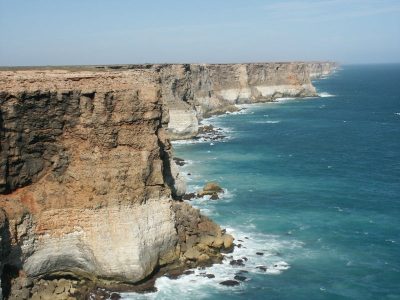Norway’s state oil company Equinor is being accused of making a “sham” out of the public feedback process over its highly controversial oil drilling plans in the rough and deep seas off Australia’s southern coast. It only responded to 13 of around 32,000 public comments in its draft plan for the Great Australian Bight, and is pushing ahead with its drilling project despite loud public resistance.

“Norwegian oil giant Equinor could not be more contemptuous of the Australian people,” claims Peter Owen, director of the Wilderness Society (for) for South Australia. “Equinor lodged its Environment Plan on the last day it could to avoid a government-regulated public feedback process. Instead it ran its own sham feedback process and has dismissed almost all concerns in 30,000 unique submissions in just five weeks.”
Equinor acknowledges there were actually around 32,000 submissions. Enviromental activists have also mounted more than 10,000 demonstrations from Western Australia to Queensland in the east just in the past month. They claim that only 20 percent of Australians support offshore oil drilling, while two-thirds of Australians want the waters of the Bight to be listed as a UN World Heritage site.
Those protesting Equinor’s exploration plans in the Bight seem most upset that the Stavanger- and Oslo-based company, which changed its name from Statoil last year, had publicly promised that it would “not push through resistance” to its plans. They now view Equinor as pushing through indeed, contending that the company is all but ignoring what Owen calls “one of the biggest environmental protests Australia has ever seen.”
Equinor downplays the protests
Equinor officials defend their public hearing and comment process, which ran from February 20 to March 20. “We received a lot of comments, around 32,000,” acknowledged Jone Strangeland, who leads Equinor’s operations in Australia, to newspaper Dagens Næringsliv (DN) on Thursday. “That sounds like a lot, but if you look at other projects in Australia, it’s not unusually large.”
Strangeland told DN that after going through all the comments, Equinor determined that around 1,000 were “relevant.” He noted that “there was a lot of sharing of photos and abusive language. There were slogans like ‘Equinor out of Australia,’ and ‘Stop oil and gas,’ and some of the comments could have come from the same people several times.”
He and his colleagues therefore dismissed such “abuse.” Of the roughly 1,000 comments deemed “relevant,” many were determined to already have been addressed. The company thus decided that only 13 “concrete changes” to Equinor’s environmental impact statement for its planned drilling in the Bight were needed.
Insists Equinor ‘is listening’
Camilla Aamodt, in charge of oil and gas exploration for Equinor off both Australia and New Zealand, has earlier denied Equinor is “pressing itself” upon the Australian people or that its request for public feedback was a sham. She wrote in a commentary published in Oslo newspaper Dagsavisen earlier this month that “we have been traveling around South Australia and listening to those who live there.” Equinor hosted public meetings, she wrote, “to offer correct information,” and she and her colleagues learned “there are various points of view out there, also supporting our project. Many hope for more jobs and more activity in the area, and we have presented an environmental plan of high quality, just as the Australian authorities and local regulations demand of us.”
Aamodt was reacting in her column to an earlier editorial in Dagsavisen that suggested it was “embarrassing to be a Norwegian in Australia” right now. “Most of us have enough antennae to know when we’re not wanted,” wrote debate editor Bente R Gravklev in Dagsavisen. “Even if we think we have something to offer, we understand the signals and leave.” The former Statoil, she noted, appeared humble when it first picked up signs of oil in the Bight, with the company claiming they’d only drill if that was wanted. “Maybe it’s the scent of oil that’s triggered greed, or numbed senses enough that now (Equinor) is defying the negative signals and sticking around. Or maybe the humility was an act.”
Fear of oil spills
It’s been noted that both BP and Chevron left the area, with Dagsavisen reporting how the former Statoil bought 30 percent of BP’s licenses after its drilling applications were turned down twice. The Guardian has reported that BP’s studies showed that an oil spill could soil Australia’s southern coast to a much greater degree than first believed.
Statoil/Equinor officials now point to how the Bight has been opened for petroleum operations by Australian authorities, and that operations are “strictly regulated.” Equinor claims it can “deliver energy in a defensible and sustainable manner,” backed by years of experience not least in Norway’s own often treacherous North Sea. Aamodt, for one, claimed she was absolutly not embarrassed to be a Norwegian in Australia: “I have worked as a geologist in this industry for 19 years, and I am certain we can drill … in a secure and safe manner.”
Now it’s up to the Australian authorities to determine whether Equinor’s environmental plan, with its 13 modifications, is good enough “and we expect several rounds of dialogue with them,” Aamodt wrote. That suggests hard lobbying on Equinor’s part, as the environmentally concerned public and politicians carry on their own.
“How much more reputational damage does the Norwegian Government-owned company want?” asks oil opponent Owen rhetorically in his statement from Wilderness Society South Australia. Equinor still hopes to receive permission to drill and start drilling next year.
newsinenglish.no/Nina Berglund

